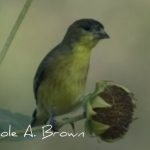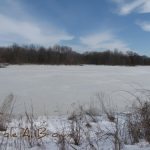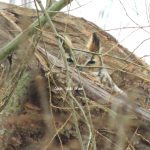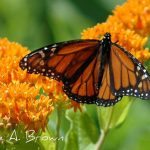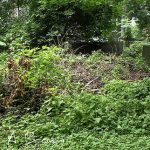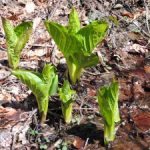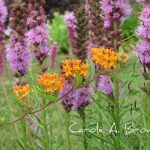(Editor’s note: This is a guest post by Ellen Sousa, garden coach, writer and teacher specializing in natural habitat landscaping. Visit her web site and New England Habitat Gardening blog. Welcome, Ellen!)
Turkey Hill Brook Farm
A New England Natural Habitat Farm
Ellen Sousa, Spencer, Massachusetts
Welcome to Turkey Hill Brook Farm! We are a small farm nestled in the Worcester Hills of Massachusetts, and we try to make our farm welcoming for all who visit and live here, including people, wildlife and a small “herd” of domestic farm animals. Just about the only creature that doesn’t feel at home here is deer! That’s because our 3 dogs prefer that no visiting wildlife should be larger than them. Which is fine with me, because I know that most deer would consider my carefully tended gardens a smorgasbord of good eats!
Thankfully, our area of central MA still has plenty of open space and natural areas for the deer to survive. That’s slowly changing as suburbia creeps nearer, so we’re working to preserve as much biodiversity as we can on our four acres. I also try to encourage my students, garden clients and friends to consider the needs of wildlife when they landscape their own properties.
When we moved here in 2004, previous owners had created beautiful garden ‘bones’ and installed many flowering shrubs and ornamental trees. Unfortunately, many areas were overrun with non-native invasive vines and shrubs such as Asiatic Bittersweet, Multiflora Rose (Rosa multiflora), Burning Bush (Euonymous alata), Japanese Barberry (Berberis thunbergii) and Japanese Goutweed (to name but a few!). I’ve seen their seedlings (spread by birds) taking over the wild areas around us, so they had to go.
Using a Weed Wrench, a lot of sweat, chains and a tractor, we removed the invasives and replanted with native plants to provide food, shelter and housing to birds, insects and the myriad of life that appears as soon as you provide them with the right habitat. Gradually, we are transitioning former lawn and garden beds into interconnected areas (corridors), filled to the brim with wildlife-friendly plants.
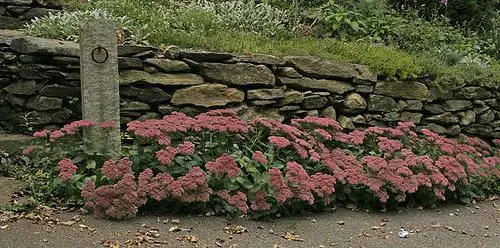
I don’t strictly use native plants, but sometimes include beautiful exotic plants which are beneficial to wildlife or the environment, but do not show invasive tendencies in our region. Sedum ‘Autumn Joy’ (above), for example, is not native to this area, but it’s a hardy plant that blooms its head off in tough conditions such as the side of a driveway. Its long-lasting flowers are jammed full of pollen and nectar to feed migrating butterflies and other late-season pollinators, and we often see Song Sparrows and Juncoes picking at their seeds later in the year.
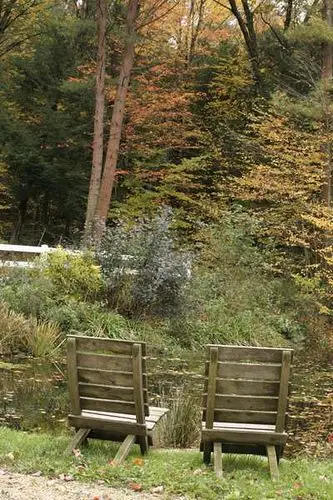
Our farm is named for nearby Turkey Hill Brook, which is one of the cleanest rivers in Massachusetts. We are trying to keep it that way, because the stream running through our land flows right down into the river and eventually our town’s water supply. So we’ve pulled existing horse fencing away from the edge of our farm pond and established a buffer of native wetland plants between the mucky areas of the barnyard and the water. The vegetation acts as a filter, preventing runoff from entering the water. The pondside plants and trees also provide protection (from predators and the elements) for the many creatures who live in or visit the pond. Our pond is a magnet for kids and adults alike, and, with all the life it hosts (fish, frogs, snakes, turtles), it’s a great place to relax and take in the view any time of the year.
During very wet years, the pond sometimes bursts its banks, so erosion has been a problem by the culvert and stream pictured below. We planted moisture-loving native plants that don’t mind occasional flooding such as Summersweet (Clethra altinifolia), Swamp Milkweed (Asclepias incarnata), New England Aster and Garden Phlox.
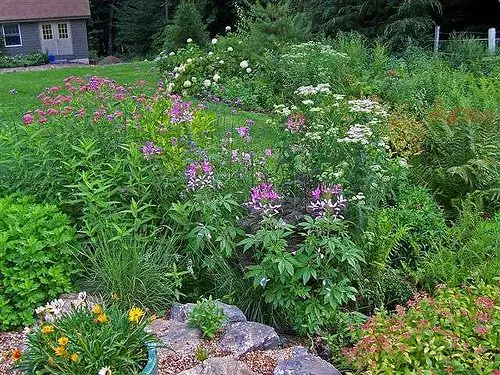
Other plants amazed me by popping up on their own! Winterberry Holly (Ilex verticillata), Elderberry (Sambucus canadensis), Boneset (Eupatorium fistulosum) and Cinnamon Fern all grow naturally in flood-prone areas of New England, so they thrive here with little fuss, and provide lots of pollen, nectar, seeds and fruits for hungry beneficial wildlife. We rarely cut down plant stems or do much fall cleanup, so this area buzzes with life right into winter as a food and watering hole for overwintering birds as well as an undisturbed place for butterfly caterpillars and beneficial insects to spend the winter.
Where it’s safe, we try to leave dying trees standing instead of removing them. Dead trees are anything but lifeless, and we often see Woodpeckers of all shapes and sizes, as well as Nuthatches and Chickadees climbing up the trunk of this Yellow Birch snag, picking at the tiny bugs and fungi that colonize in rotting wood. This sagging tree has kept us hanging on for several years now, trying to guess when it will finally succomb to gravity and come crashing down into the woods.
We grow a lot of Juniper on our farm, both the native varieties and some cultivars. Evergreen mats of Juniper (below) help to unify large garden areas, plus their scratchy evergreen foliage provides safe shelter for many birds through the long winters here. In summer, we’ve noticed that Ruby-throated Hummingbirds often pick at the spider webs that stretch across our Juniper plants. We’ve never figured out if they are stealing a free lunch from the bugs trapped in the webs, or using the webbing as a sticky binding material for their nests.
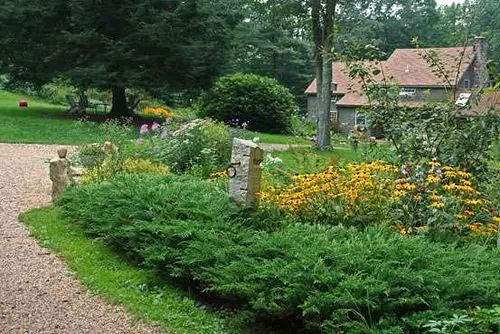
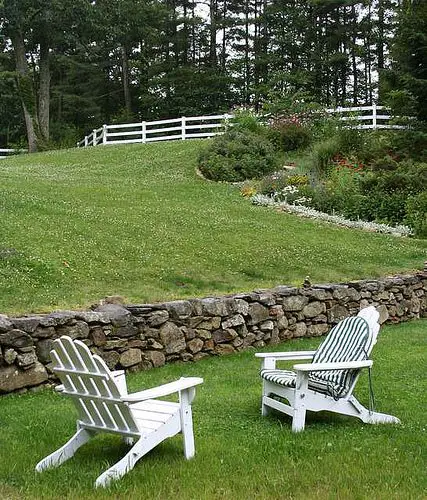
I would dearly love to take over more of this lawn and convert it into even more vegetable gardens and wildlife habitat, but my husband likes the contrasting effect and vista of an open lawn so it’s here to stay – for now! But we have compromised and he only mows the upper lawn once in a while, leaving the grass longer and allowing short meadow plants to flourish. Not only is this a low-maintenance lawn (requiring no fertilizer or irrigation), but the violets, clover, bluets, dandelion and wild strawberry of our flowering lawn provide lots of spring nectar for tiny pollinators, and their fruits and seeds are great forage for ground feeding birds such as Robins and Chipping Sparrows. The pollinating insects visiting the tiny flowers also provide a ready food source for Phoebes and Tree Swallows feeding their nestlings, whose diet is generally based on bugs. Northern Flickers and our free-range chickens tell us that the soil in our lawns is full of worms and other yummy insects, a result of using a mulching mower to chop all the leaves and grass clippings right back into the soil.
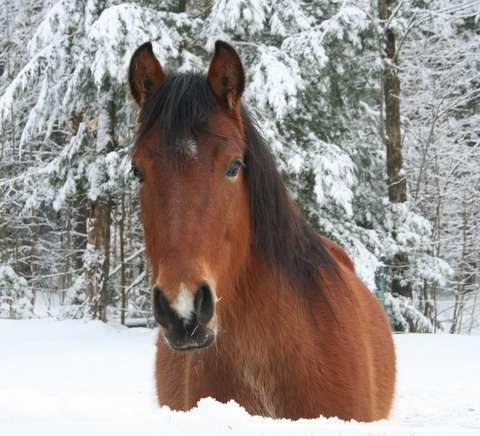
My horses are not only a joy to have around, but their manure is key to my gardening success! We compost horse manure along with stall bedding, kitchen scraps, pizza boxes, yard waste, paper shreddings and fallen leaves (of which we have plenty!). The result is an amazingly rich organic fertilizer that feeds my plants, helps retain soil moisture and improves drainage wherever it is spread. We use it in our vegetable beds, on lawns, in the pasture and as a mulch for shrub borders. Anything left over is snapped up by the truckload by clients for their own gardens.
As all gardeners know, gardening is a process and rarely a destination in itself. I’m always watching for more bittersweet seedlings and the many other invasives who find our conditions hospitable. Trying to garden in a cold north-facing river valley means that sometimes I have to sit back and let nature teach me how to garden. That means observing what native plants pop up on their own, and cultivating them instead of trying to force an unwilling plant from another part of the planet to thrive in the unique microclimates that make up this property.
Our farm is certified as a Monarch Waystation by Monarch Watch, and as a Backyard Habitat by the National Wildlife Federation. Both organizations provide lots of resources to families who want to reconnect with nature in their own backyards.
And I continue to add as many regionally native plants as I can pack into my garden areas. After recently reading Douglas Tallamy’s Bringing Nature Home, I have a renewed commitment to providing local wildlife with the familiar local plants that they’ve relied upon for eons of evolutionary history. We plant lots of different native Milkweeds for Monarch butterfly caterpillars to eat (right), and hope that in our small way we might help prevent them from what may be a sadly inevitable extmy inction.
Caring for horses on a small farm in New England is not always a smooth ride, but the daily routine gives us many opportunities to step back and take in the beauty and drama of the natural world that surrounds us. And most visitors (except for those deer!) would agree, our habitat farm is a peaceful haven, a sanctuary from the frenzy of the outside world. It’s a good life!
All photos copyright Ellen Sousa.
(Kudos, Ellen! Thank you for sharing your garden with us. Yes, I agree, Doug Tallamy’s book is certainly amazing, and a wake up call for the necessity of using native plants when planning and Ecosystem Garden).
More From Ecosystem Gardening:
Submit your review | |


